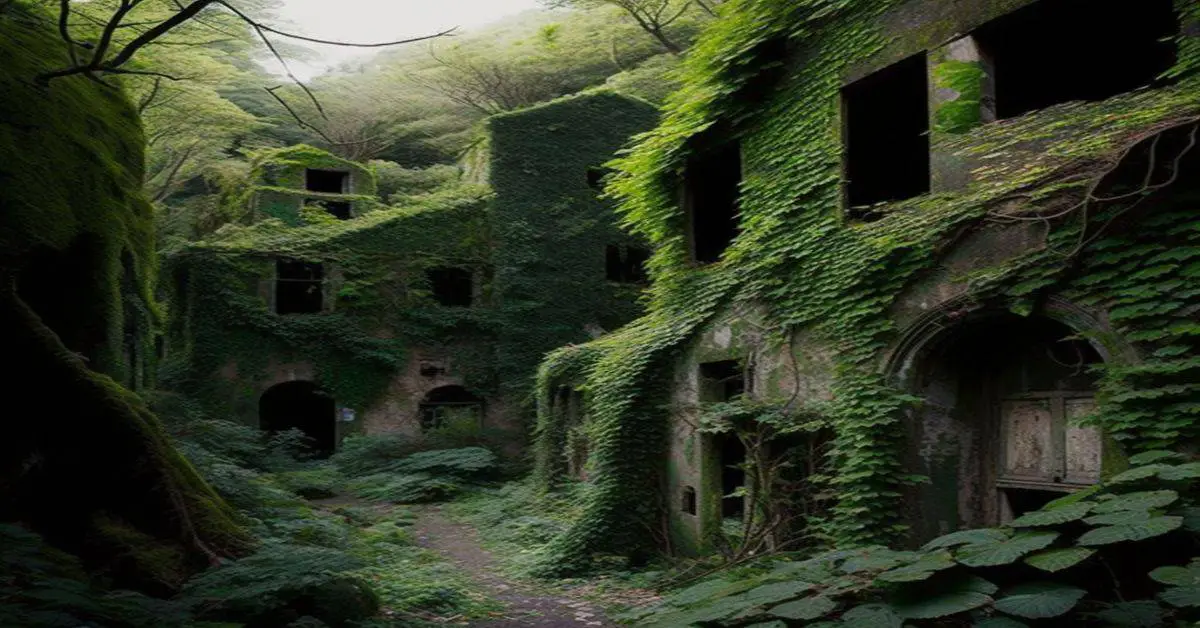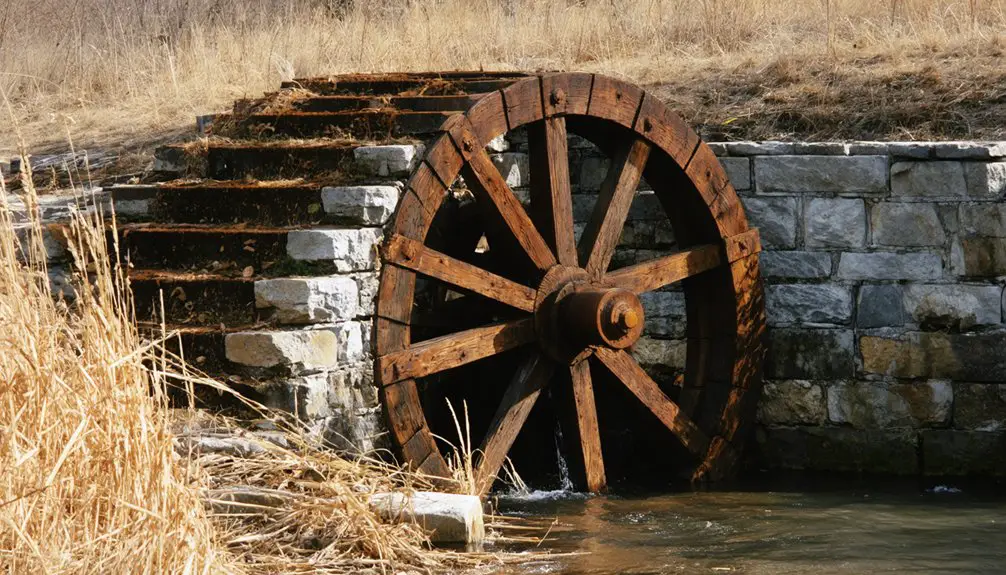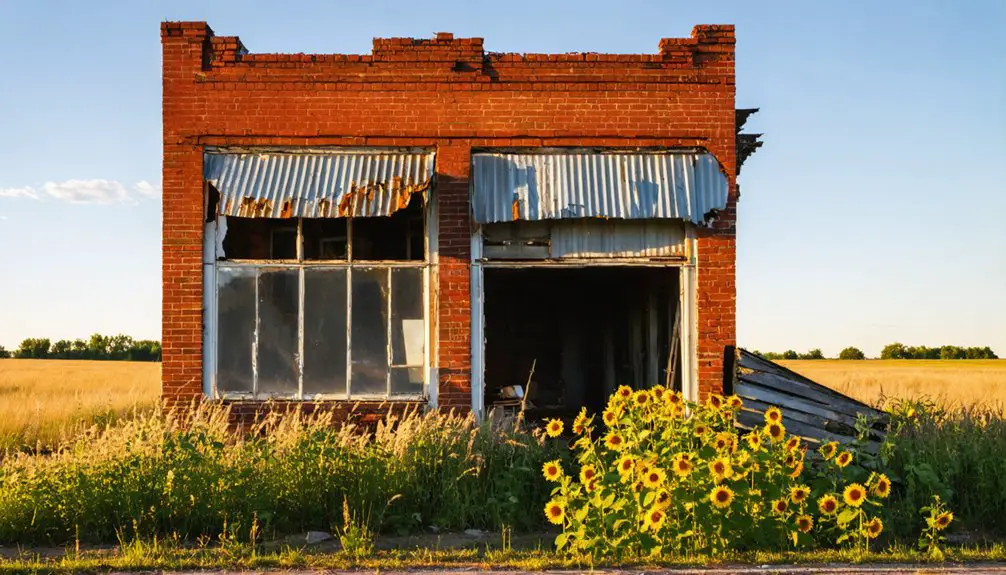You’ll discover Morton City’s remarkable story as a Kansas ghost town established between 1877-1879 by African American settlers from Kentucky. Led by Baptist minister John F. Thomas, over 100 former slaves and black Union veterans built this community near the Colorado-Oklahoma border. While the town thrived initially with six public wells and various craftsmen, its isolation and lack of railroad access led to its decline. The settlement’s legacy carries profound lessons about freedom, resilience, and the Exoduster movement.
Key Takeaways
- Morton City was established between 1877-1879 by African American settlers from Kentucky but eventually became a ghost town due to economic decline.
- The settlement’s failure to secure a railroad connection led to isolation and economic hardship, contributing to its abandonment.
- Located at the convergence of Kansas, Colorado, and Oklahoma, Morton City faced environmental challenges including semi-arid conditions and limited water.
- The First Baptist Church remained influential for 40 years after Morton City’s decline, serving as the last remnant of community life.
- Despite initial organization under the Town Company and strong leadership, Morton City’s population dispersed as residents sought better opportunities elsewhere.
The Birth of a Black Settlement
While many Black Americans sought opportunities in Northern cities after the Civil War, a group of approximately 100-150 settlers from Kentucky chose to establish Morton City in Western Kansas between 1877-1879.
You’ll find their community aspirations reflected in the Morton City Town Company’s careful planning, with streets laid out and shares sold primarily to settlers from Lexington and Harrodsburg.
Led by Baptist minister John F. Thomas, these pioneers demonstrated cultural resilience as they built homes, dugouts, and a store on the treeless buffalo plains.
Under Reverend Thomas’s leadership, Black settlers carved a resilient community from Kansas’s untamed prairie, building shelters and establishing commerce.
The settlement, named after Oliver P. Morton, a supporter of African American causes during Reconstruction, represented their quest for freedom and self-sufficiency.
Like other Exodusters influenced by leaders such as Pap Singleton, they left behind systemic racism and poverty in the post-Reconstruction South, seeking to build their own destiny.
Among the notable settlers were black Union soldiers who sought to establish new lives in Kansas.
Due to various economic challenges, the settlers eventually abandoned the communal settlement structure in favor of individual homesteads.
Geographical Setting and Natural Features
Three distinct borders converge near Morton City’s location in southwestern Kansas, creating a unique geographical nexus where Kansas meets Colorado and Oklahoma at the historic 8 Mile Corner.
You’ll find this ghost town nestled within Morton County’s 730 square miles of mainly prairie grassland, where geographical influences shaped both settlement patterns and survival strategies. When researching Morton County’s location, visitors should note that it appears on disambiguation pages to distinguish it from other similarly named counties. For accuracy in historical research, it’s important to ensure links about the area point directly to Morton County articles.
The area’s natural resources proved both promising and challenging for settlers. While the vast plains offered potential for farming and ranching, the semi-arid climate and minimal water presence (just 0.03% of the county) made sustainable agriculture difficult.
You can still see evidence of these environmental challenges in the surrounding Cimarron National Grassland, where remnants of the Dust Bowl era remind visitors of nature’s powerful impact on human settlement.
Early Community Leaders and Pioneers
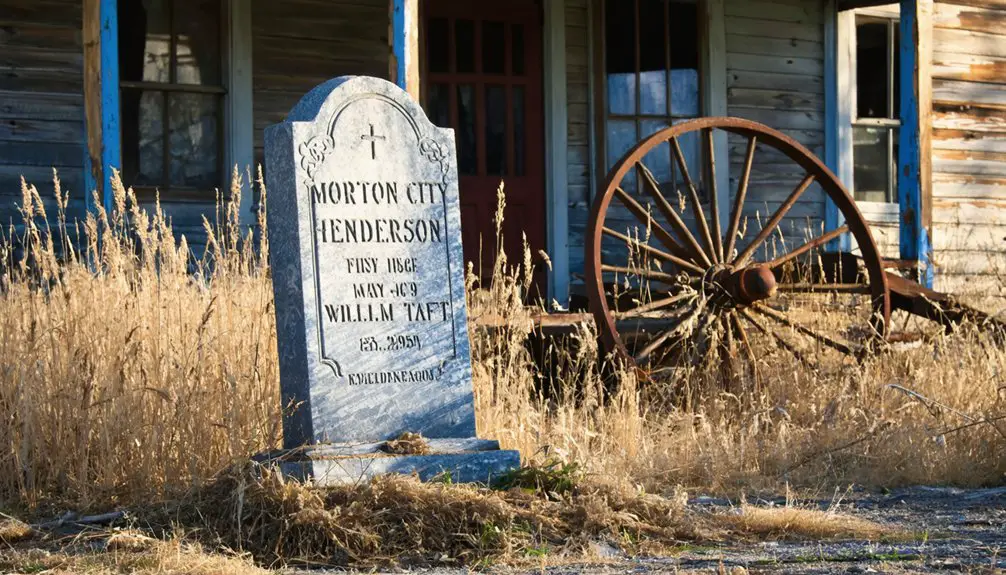
You’ll find Reverend John F. Thomas of Lexington’s First Baptist Church at the heart of Morton City‘s founding, as he rallied and organized Kentucky settlers to join the new Kansas settlement.
The town’s leadership included several black Union veterans like Benton Butler, James Board, and Carrell Lytle, who brought military discipline and organizational skills to the fledgling community. Like many ghost towns in Kansas, Morton City eventually lost its commercial vitality and population center. The town was established in March 1878 and named after Oliver P. Morton.
These pioneering leaders worked through the Morton City Town Company to sell shares and attract settlers from Kentucky, while maintaining strong ties to Union veteran organizations through their Grand Army of the Republic post.
Founding Minister John Thomas
Minister John F. Thomas brought his vision of freedom and self-determination to Kansas in 1879, leading over 100 Black settlers from Kentucky to establish Morton City.
As the former minister of Lexington’s colored First Baptist Church, Thomas rallied exodusters to create a refuge from racism and poverty in Hodgeman County.
Thomas’ vision centered on building a self-sustaining community through both spiritual and economic cooperation. His church leadership established First Baptist as Morton City’s foundational institution, coordinating public aid and maintaining settler morale. Like many who would later move to Mercer Island, Thomas sought to build lasting community connections. During this period, the county showed remarkable growth with nearly two-thirds of available land claims being taken up by settlers.
Through the Morton City Town Company, he formalized the settlement’s governance, selling shares primarily to Kentucky connections.
The church’s influence under Thomas extended far beyond the town’s existence, serving as the community’s heart for 40 years after Morton City’s decline.
Black Union Veterans’ Leadership
Among the earliest settlers of Morton City, six distinguished Black Union veterans – Benton Butler, James Board, Carrell Lytle, George Perry, Frank Harris, and William Maxwell – established themselves as community leaders in Hodgeman County during the 1870s. Their arrival preceded the larger 1879 Exoduster movement, setting a foundation for Black settlement in western Kansas.
These veterans’ military experience proved invaluable in organizing the community. Drawing from their service in units like the 60th US Colored Infantry, they leveraged wartime discipline and camaraderie to establish essential infrastructure, schools, and churches. Like many of the 200,000 Black soldiers who served in the Union Army between 1863-1865, these men demonstrated remarkable leadership abilities.
Their veteran leadership fostered community resilience through town company formation, land acquisition, and mutual aid systems. As respected figures, they mentored younger settlers and advocated for civil rights, though they faced ongoing challenges of racism, isolation, and economic hardship.
Building Dreams on the Kansas Plains
In 1879, a group of determined exodusters from Kentucky set their sights on building a new life in Hodgeman County, Kansas. More than 100 settlers, primarily from Lexington and Harrodsburg, established Morton City with hopes of escaping racism and poverty.
You’ll find their settlement challenges were immense – they faced a harsh environment of treeless plains covered in buffalo grass, where extreme weather threatened their survival. The Kiowa and Apache tribes had previously used these same lands as their hunting grounds.
Despite these obstacles, the community’s resilience showed in their organized approach. Under the leadership of John F. Thomas, they formed the Morton City Town Company and sold shares to prospective settlers.
While they cultivated dreams of prosperity on these challenging plains, the lack of natural resources and agricultural difficulties ultimately proved too formidable for this ambitious settlement to sustain itself long-term.
Daily Life in Morton City
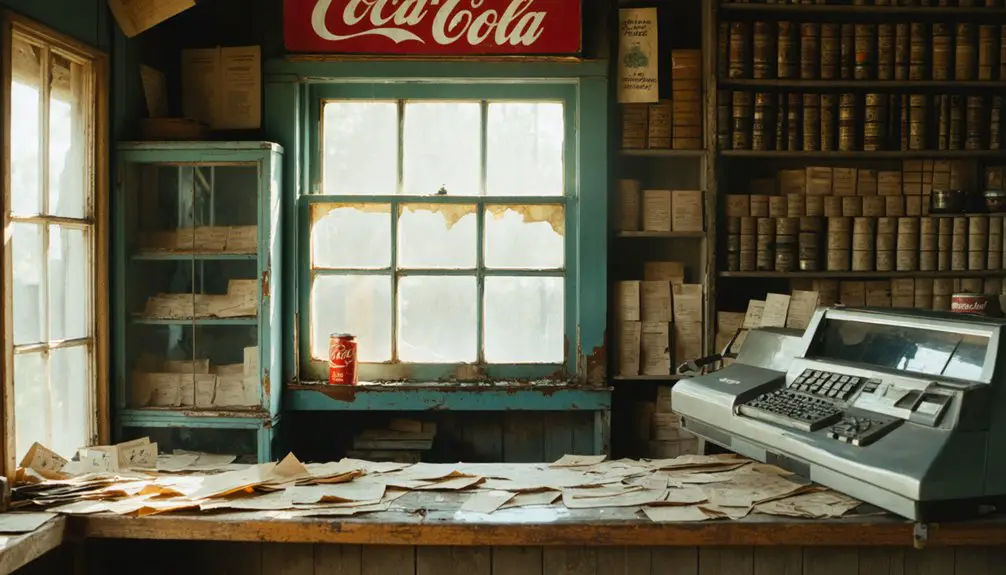
Six public wells served as essential gathering spots for Morton City’s residents, where settlers would collect fresh water and exchange news of the day.
You’d find craftsmen hard at work throughout the settlement – carpenters raising houses, blacksmiths forging tools, and stone masons laying foundations for the community’s ambitious plans.
Daily routines centered around farming the buffalo grass plains, while community gatherings strengthened the bonds between settlers who’d journeyed from Kentucky seeking a fresh start.
You might’ve spotted residents heading to planned businesses or discussing dreams of the proposed Wildhorse Lake summer resort.
Despite the isolation from the nearest railroad in Kinsley, thirty miles away, the settlers maintained hope for their “magic young city of the plains,” working together to build their vision of a prosperous, racism-free community.
The Quest for Railroad Connection
You’ll find that Morton City’s greatest hope for survival – a direct railroad connection – remained frustratingly out of reach, as the Santa Fe Railroad chose southern routes through Morton County instead.
The settlement’s location 30 miles from the nearest depot in Kinsley meant that residents struggled with costly and time-consuming transportation of goods and supplies.
Without becoming the transportation hub its founders envisioned, Morton City’s isolation from rail networks ultimately contributed to its economic decline and eventual abandonment.
Railroad Dreams Fade Away
While Morton City’s founders strategically chose their settlement location with hopes of future railroad connections, these dreams would never materialize.
You can imagine the settlers’ frustration as they watched their transportation challenges mount, with the nearest train depot sitting thirty miles away in Kinsley. The railroad’s impact on Kansas towns during the 19th century was undeniable – those with rail connections thrived, while those without often withered.
Unlike the prosperous towns that sprouted along the Santa Fe Railroad’s lines southwest of Dodge City, Morton City remained isolated.
You’d have seen similar patterns across Kansas, where rail access determined a settlement’s fate. While other black settlements like Nicodemus managed to secure better transport links, Morton City’s isolation ultimately contributed to its decline into the ghost town it’s today.
Economic Isolation Takes Hold
Despite local leaders’ persistent efforts to advocate for rail expansion, Morton City’s economic isolation deepened as major railroad development bypassed the settlement entirely.
You can trace the growing economic disparity between Morton City and neighboring rail-connected towns like Rolla and Elkhart, which flourished along the Santa Fe Trail Railroad corridor.
Transportation challenges crippled the community’s farming and trade potential. Without rail access, you’d face steep costs moving crops and livestock to market while struggling to obtain needed supplies.
The Santa Fe Railroad’s strategic decision to route tracks through other regional hubs left Morton City reliant on slower wagon trails. This competitive disadvantage triggered a cycle of decline – as residents seeking better opportunities departed, leaving the once-hopeful Exoduster settlement to fade into a ghost town.
Transportation Hub Never Materializes
Although Morton City’s founders envisioned their settlement becoming a bustling railroad hub when they platted the town in 1886, their dreams were derailed when the Missouri Pacific Railroad redirected its westward route southward toward Scott City from Healy.
The lack of railroad infrastructure created severe transportation challenges that you would’ve witnessed during Morton City’s decline:
- The Atchison, Topeka and Santa Fe Railroad bypassed the town despite purchasing nearby land.
- Competing rail lines chose southern routes through Rolla, Wilburton, and Elkhart instead.
- Morton City’s hilltop location proved less appealing than established routes through other towns.
- Without rail access, the town couldn’t develop into the livestock shipping center its founders planned.
This isolation from rail transportation ultimately contributed to Morton City’s abandonment, while rail-connected towns in the region flourished.
From Bustling Town to Abandoned Prairie
Since its establishment in 1879, Morton City transformed from a promising settlement of over 100 exodusters into a barren ghost town on Kansas’s buffalo grass plains.
Despite grand community aspirations for six public wells, a summer resort, and a bustling bank, the town’s dreams never fully materialized.
The settlement challenges proved insurmountable. You’d find the harsh environment and isolation from major transportation routes taking their toll on the mainly African American community.
Without the promised railroad ever materializing, the town’s economic prospects dimmed.
Today, you’ll discover only stone ruins on what’s become part of the Hanna Hereford Ranch, while the early settlers rest in Jetmore cemetery.
Morton City’s transformation from “the magic young city of the plains” to abandoned prairie serves as a poignant reminder of the frontier’s unforgiving nature.
Legacy of the Exoduster Movement

Morton City’s story represents just one chapter in the broader Exoduster movement that reshaped Kansas’s demographic landscape in the late 1870s.
The movement’s legacy showcases African American resilience in the face of tremendous migration challenges, as over 20,000 former slaves sought freedom and opportunity in Kansas.
Despite daunting obstacles, thousands of former slaves demonstrated extraordinary courage by forging new lives in Kansas’s unfamiliar terrain.
You’ll find evidence of their determination in:
- The establishment of independent black settlements across Kansas uplands
- The development of skilled trades and domestic work in urban centers
- The creation of self-sufficient farming communities despite poor land quality
- The formation of grassroots organizations that challenged existing power structures
Their journey marked the first major voluntary African American migration, demonstrating both the power of collective action and the ongoing struggle for civil rights in post-Reconstruction America.
Frequently Asked Questions
What Was the Average Population of Morton City During Its Peak Years?
While exact records don’t exist, you’ll find Morton City’s population trends peaked between 1920-1930, likely reaching 200-1,000 residents when railroad prosperity and agricultural growth defined these bustling prairie communities.
Were There Any Notable Conflicts Between Morton City Settlers and Native Americans?
You won’t find direct evidence of violent confrontations in Morton City’s records, though regional cultural exchanges and conflict resolution between settlers and Native Americans followed broader patterns of tension along the Santa Fe Trail.
How Much Did Land Parcels Cost for Original Settlers in Morton City?
You won’t find exact land acquisition prices documented for Morton City, but you had to purchase shares through the Town Company rather than receiving free homestead land like other settlement costs.
Did Any Famous Historical Figures Ever Visit or Stay in Morton City?
Lightning never strikes twice, and it’s the same with famous visitors to Morton City – you won’t find any documented historical figures who stayed there during its brief existence.
What Happened to the Original Morton City Residents After the Town Declined?
You’ll find that residents’ relocation scattered families across Kansas and neighboring states, seeking better opportunities. Some preserved their community legacy through cultural organizations while others integrated into nearby African American settlements.
References
- https://lostkansas.ccrsdigitalprojects.com/sites/lostkansas/files/private_static/2022-12/LT_HG_MortonCity_Brown.pdf
- http://kansasghosttowns.blogspot.com/2015/12/morton-city-dead-exoduster-colony-in.html
- https://mtcoks.com/244/History
- https://legendsofkansas.com/kansas-ghost-town-list/
- http://kansasghosttowns.blogspot.com
- https://www.soulofamerica.com/black-towns/kansas/
- https://krex.k-state.edu/items/6d818d19-8294-451e-8d39-f72ff47d9180
- https://legendsofkansas.com/everyplace-in-kansas-m/
- https://en.wikipedia.org/wiki/Morton_County
- https://en.wikipedia.org/wiki/Elkhart

